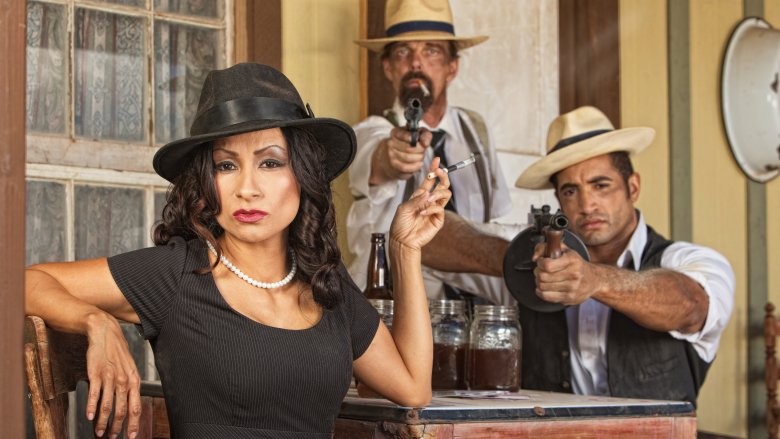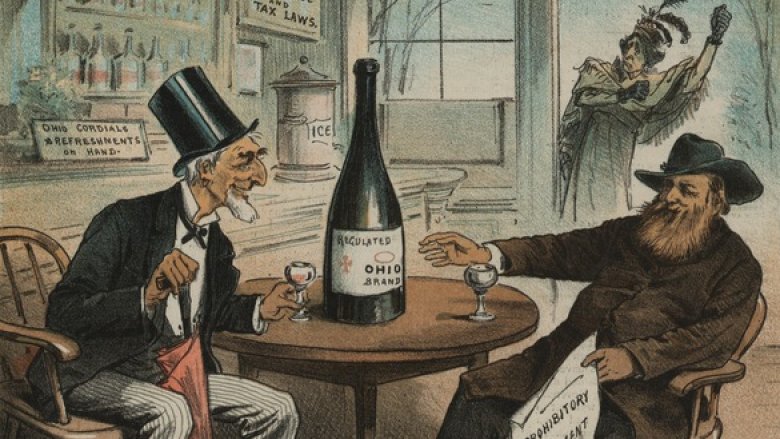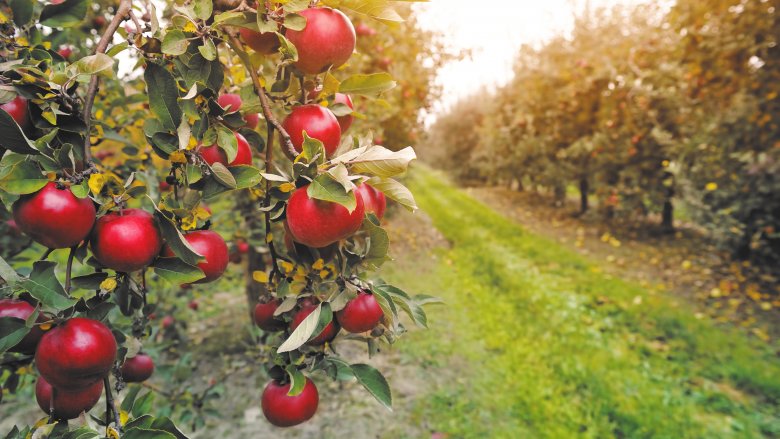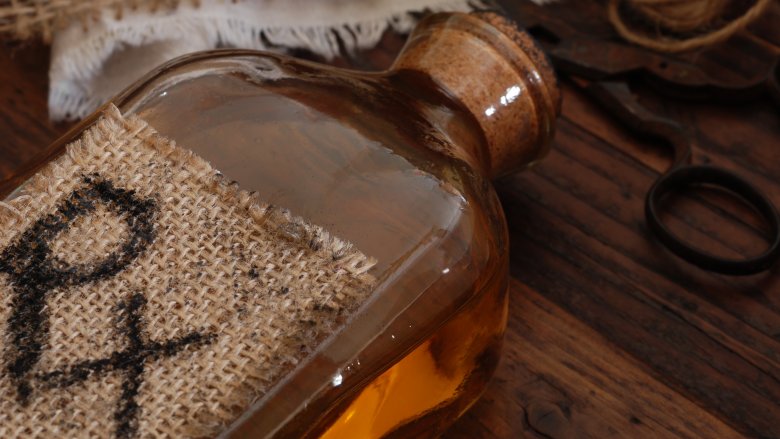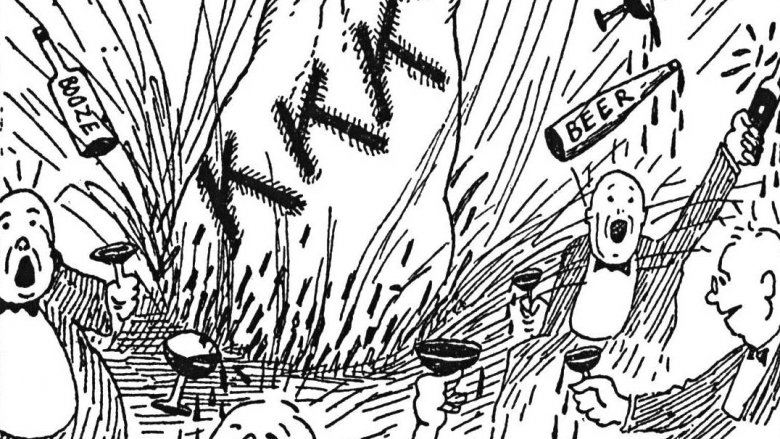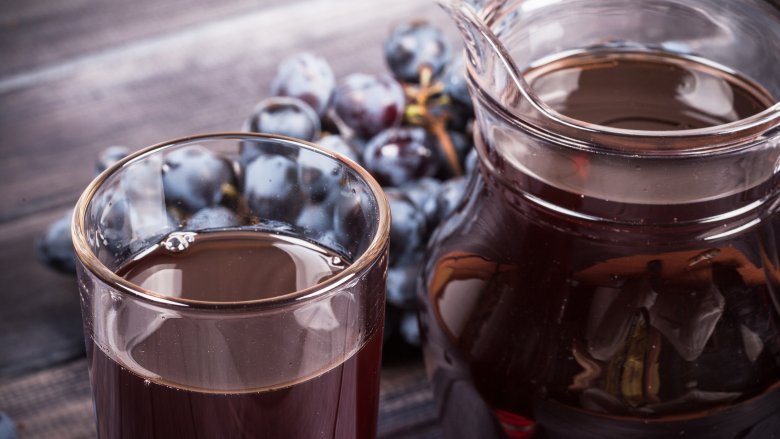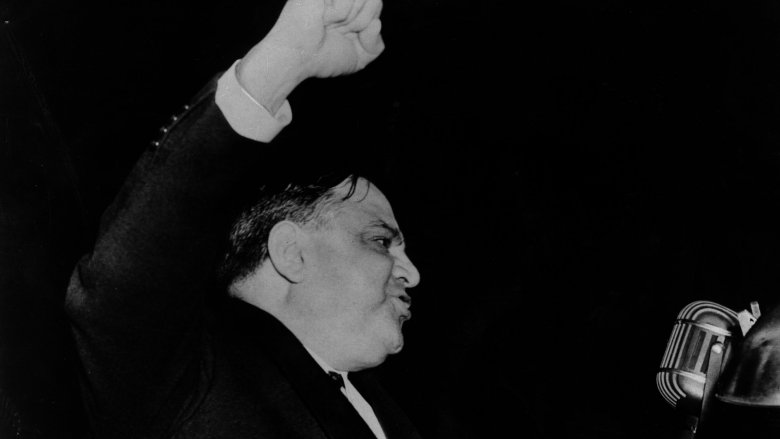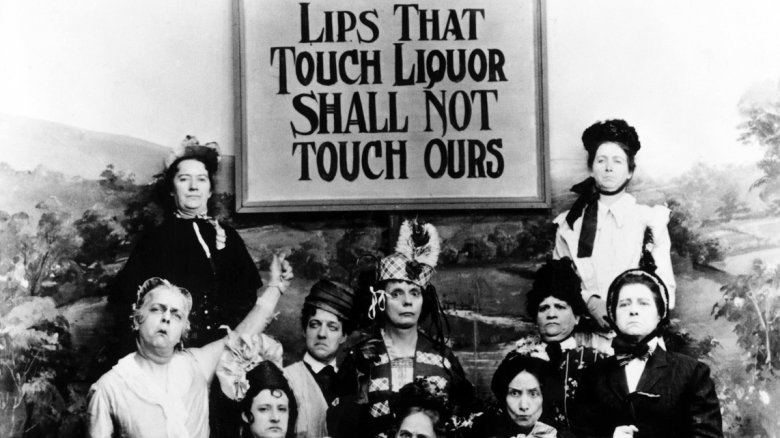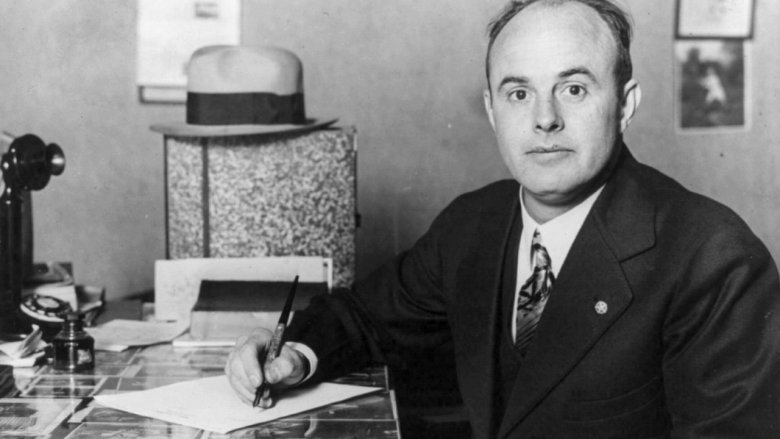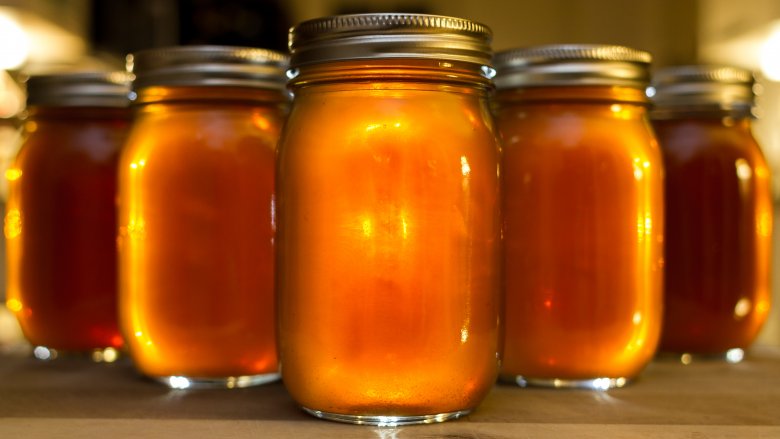The Untold Truth Of Prohibition
There have been plenty of dark times in history, but humans have usually had alcohol to help us deal with the day-to-day horrors that come with being an adult. Prohibition took even that away from us — or tried to. And that made for some dark, dark times. None of it was pretty.
The government poisoned barrels of alcohol to make a point
Where there's a will, there's a way, and people have been finding ways to drink for at least 6,100 years. When making booze illegal didn't actually stop people from partaking, the U.S. government pulled another trick out of the hat: poison.
Bootleggers got their alcohol from different sources. Some made their own from scratch. Others took a shortcut and bought industrial alcohols (used to make paints and medical supplies), distilled them to remove all the nasty stuff, and resold them as drinkable goodness. Desperate times, huh? Times got more desperate when at least 31 people died from drinking poisoned industrial alcohol hooch around Christmas 1926. The government had caught on to the bootleggers' scheme and ordered things like mercury salts, formaldehyde, and quinine to be quietly added to these industrial alcohols. Some poisons accounted for as much as 10 percent of the product. We know exactly what they added, mostly because The Poisoner's Handbook author Deborah Blum found laundry lists of chemicals published by New York City's medical examiner and his toxicologist after the Christmastime deaths.
Those deaths were the first, but they weren't the last. Protests over the government-sanctioned poisonings became a rallying cry of anti-Prohibitionists as death tolls climbed into the hundreds. By the time Prohibition was repealed, poisoned liquor may have killed as many as 10,000 people.
Apple orchards were destroyed to stop the cider industry
America is largely a land of beer drinkers, and if you've ever wondered why cider has only seen a resurgence recently, you can thank Prohibition for ruining that, too.
Before Prohibition, cider was the drink of choice throughout rural America. When homesteaders moved westward, they were given lands to settle on. There was a catch: they needed to plant 20 peach trees and 50 apple trees on that land. John Chapman — better known as Johnny Appleseed — saw a massive business opportunity in prepping land for sale. He went ahead planting trees all across the country, and according to The Botany of Desire author Michael Pollan, none of those sour apples were for eating. They were for making hard cider, and people drank a lot of it. Daily.
Chapman died in 1845, and it was only a few decades later that most of his orchards were destroyed by zealous, ax-wielding FBI agents plus also fire-wielding temperance crusaders. Since his trees only produced bitter apples that were only good for one thing, Prohibition's crusade against alcohol extended to Johnny Appleseed's apple orchards, according to National Geographic's The Plate. Apples became about eating, and hard cider fell to the wayside.
Breweries and distilleries stayed in business in some weird ways
Prohibition didn't just impact those who fancied a drink after a long day; it also threatened to put breweries and distilleries out of business. If they wanted to keep their doors open and their workers employed, they needed to find a workaround for an indefinite length of time. Thriving (or just plain surviving) required creativity.
California's San Antonio Winery was only founded a few years before Prohibition started, and it weathered the storm by producing sacramental wine for religious institutions. It still does today. Yuengling started making ice cream (it's also still doing that), and Anheuser-Busch did ice cream and a handful of other products, including truck bodies and a non-alcoholic grain-based drink called Bevo. Coors started making pottery, churning out everything from tea sets to spark plugs. (CoorsTek today has more than 40 facilities for making technical ceramics.) Miller had it a bit tougher, and its diversification into malt syrups, milk, soda, and other beverages almost killed the company. Other companies, like the Lion Brewery and F&M Schaefer Brewing, converted their existing businesses into dye manufacturing plants. Since the setups were similar, some companies used the dye business as a front for illegal alcohol manufacturing. One such business, Heller & Merz, was producing $35,000 worth of moonshine a day when it was raided in 1931. That's a lot of booze to dump down the drain.
You could get a prescription for 'medicinal' booze
If the idea of facing every day without a nip of something special sounded just too horrible, there was a loophole. You could hit up your doctor for a prescription for some medicinal whiskey, as much as a pint of whiskey every ten days. Six whiskey distillers were granted special licenses to produce this vital medicine, including Old Fitzgerald, JW Dant, and Old Hermitage. In theory, each pint should have been labeled for medicinal use only, but many went unlabeled, probably because "Ah, screw it."
The prescription itself cost $3, which is about $36 in today's cash. Each refill cost between $3 and $4, and no, most of the people who got them didn't have a medical need for them in the slightest. Some labels directed patients to use them if faced with an "emergency." "Uh oh, trouble on the horizon, doctor! Write me a scrip."
George Remus, King of the Bootleggers
If you've never heard of George Remus, you've certainly heard of the character he inspired: Jay Gatsby. According to the Cincinnati Enquirer, the real figure was just as larger-than-life, an attorney and pharmacist who turned to bootlegging to make a fortune during Prohibition. He started out defending smugglers and used his experience to exploit the medicinal whiskey loophole. Remus bought scores of distilleries, all producing medicinal liquor. That liquor was often conveniently "stolen" and then sold on the black market. If Remus was making the same kind of cash today, he'd be pulling in around $900 million a year.
Even though he built his empire on dirty dealings and bribery, he donated huge amounts to charity and people in need. Remus was arrested in 1925, but the story didn't end there. His cellmate was Franklin Dodge, who got cozy with Remus. Remus even explained how all his money was safe with his wife, hidden from the government's prying eyes. As it happened, Dodge was an undercover FBI agent who should have been keeping tabs on the management at the prison. When this juicy info fell into his lap, he quit his job, left prison, and started an affair with Imogene Remus. She sold everything and left George with $100 when he got out of prison. She filed for divorce, but George stalked her down on her way to court, shooting and killing her. After a verdict of not guilty by reason of insanity, he had a short stay in an asylum, then got out, tried (and failed) to get back in the booze game, and then lived a quiet life in Cincinnati.
One of the biggest champions was the KKK
One of the driving forces behind Prohibition was the Anti-Saloon League, and one of its closest allies was the KKK, for terrible reasons.
The KKK hated a lot of people, including Irish and Italian immigrants and anyone who was Catholic or Jewish. The Klan's leader at the time, Hiram Evans, decided that one of the best ways to hit them all where it hurt was to take away liquor. The KKK was terrifyingly popular. It muscled its way into vigilante law enforcement, and KKK-backed candidates were elected to offices across the country. From their positions of power, they cracked down and supported Prohibition to the letter.
Klan members took their jobs very seriously. Saloons were torched, speakeasies were destroyed, and armed patrols were sent out to tar and feather bootleggers. It wasn't unheard of for people to be killed for drinking, which many Prohibitionists supported. According to Professor David Hanson of SUNY, the list of proposed punishments for drinking included exile to concentration camps, public confinement to cages, sterilization, and execution of the offender and all progeny four generations down the line. Actually ... kind of a perfect match for the KKK.
You could buy grape bricks that were definitely not for wine
For every bad idea like Prohibition, there are a couple shining examples of how awesome people can be if they just try. Distilleries and breweries weren't the only businesses hit by Prohibition. Won't someone think of the vineyards? While some destroyed their grape crops and planted other things, others got creative with their grapes. Grapes weren't illegal, but if they were ultimately used to make wine, the grower could be in hot water. But if the grower didn't know and took every precaution, well, they ultimately couldn't help what people decided to do with the product, right?
Enter the grape brick. These bricks were grape concentrate, and the responsible buyer could dissolve them in water to make completely legitimate grape juice. The bricks would include instructions on how to do it, along with explicit instructions not to leave the jug in a cool, dark place for 21 days lest it to turn into wine. Thank heaven for warning labels.
Not surprisingly, they were a huge success. Some companies even labeled their grape bricks with the flavors — like Riesling — buyers could expect. And since plenty of vineyards had destroyed their grapes, crop prices skyrocketed more than 3,800 percent. American ingenuity at its finest, folks.
New York City's future mayor protested by drinking in D.C.
Prohibition was instituted by the government, but it definitely didn't have the support of all government officials. Fiorello La Guardia, who would later become one of New York City's most famous mayors, didn't just dislike Prohibition — he actively protested it.
In 1926, he was three years into serving in the House of Representatives, and he staged a protest that made his stance on Prohibition very clear. Calling a slew of reporters to a conference in the House Office Building, he stood in front of them with something called a near beer. With its low alcohol content it was legal at the time, but then he mixed in some malt tonic and it wasn't low-alcohol anymore. After drinking it, he declared it legal, then pointed out that Prohibition had done nothing but create a nationwide contempt for the legal system. It's no wonder he was popular with the people and not popular with Congress.
It gained traction thanks to some seriously bizarre beliefs
As Professor Hanson of SUNY points out, the Woman's Christian Temperance Union was a major player in the push for nationwide Prohibition, and it preached some seriously wild stuff from the street corner soapboxes and in schools. It even approved textbooks for teaching Scientific Temperance Instruction, and these books included "facts" like the idea that alcohol dependence was inherited, or that alcohol stunted growth, turned blood into water, and could turn food in your stomach into poison if you ate and drank at the same time.
And there's so much more. The WCTU claimed alcohol could make someone spontaneously combust, that the only source for it was decaying plant matter, and that it was actually "the excretion of a fungus." If a beer had a nutty flavor, that was a clear sign it had been made with cockroaches. People who drank might randomly drop dead of dropsy (edema), have the linings of their throats burned off with every drink they took, and could even suffer from things like epilepsy, hysteria, gout, and a general sort of insanity. All because of booze!
The WCTU also used classroom demonstrations, including one where the teacher would put a calf's brain in a jar and fill the jar with alcohol. When the color of the brain changed, students were told that the same thing would happen to their brains. Every drinker has had a rough night, but no matter how pickled your brain might feel, at least you know it's not actually pickled.
Congress had its own personal bootlegger
Maybe you've gotten the impression that the federal government was really strict about Prohibition. And it was, but only to a point. Prohibition was one big "Do as I say, not as I do" moment.
Want proof? Congress had its own personal bootlegger. George Cassiday was a World War I vet who turned to bootlegging as a post-war employment option. In 1920 he started smuggling bottles into the House of Representatives under his coat. According to what his son told the Washington Post, it wasn't long before his services were in such demand that his clients set aside some space for him in the House Office Building, and he started shipping his booze right into the heart of D.C. When he got busted for bringing booze into the House, he took his business elsewhere — to the Senate.
He was arrested again in 1929 and wrote a series of articles for the Washington Post. He gave details without giving names, and the man known as The Man in the Green Hat was sentenced to a year in jail. Post-Prohibition, he worked at a shoe factory and drank Yuengling. When he died in 1967, his wife burned his client ledger.
'Bathtub gin' doesn't mean what you think it means
You've probably heard the term "bathtub gin," and while it does come from the Prohibition era, there's not a shred of evidence that gin was ever made in bathtubs.
Bathtub gin was one of the more popular drinks, mostly because you didn't need a still and you didn't need to let it ferment for a long time. You made it in a jug filled with water, juniper berries, and grain alcohol, and people who made it usually made a large batch in a large jug. Since those jugs were too big to fit in a kitchen sink, the water usually came from the tap of a bathtub. There was no mixing of ingredients in the same place your dirty feet went, even though gin still tastes a little bit like soap.
One illegal beverage paralyzed around 100,000 people
Sure, you've probably said you could "kill for a drink" after a long day, but would you die for one? In 1930, a wave of paralysis swept across the country. It was characterized by impotence and paralysis from the knees down, and it was linked to an illegal alcoholic drink called jake. Listen to Prohibition-era blues (like the song above) and you'll probably hear references to the paralysis as "jake leg."
It started with Jamaica ginger, which was a generic, snake oil sort of cure-all. It was alcoholic, though, and it stayed on the shelves because it was sold as medicine. In order to dissuade people from drinking it for fun, the government ordered oils and resins to be added. Two Boston men, Harry Gross and Max Reisman, found a way around the law. They consulted with a chemist — without telling him what they were doing — and at his advice they added tri-ortho-cresyl to make their Ginger Jake legal. That horror concoction caused major muscle spasms and death. The men were arrested and prosecuted, but not before their Ginger Jake had crippled as many as 100,000 people.
Budweiser's Clydesdales were assembled to celebrate the repeal
They're the most iconic symbol of any alcoholic beverage — they're the Budweiser Clydesdales. The teams of horses that star in the epic Super Bowl commercials isn't the original group. The first beer-promoting Clydesdales were assembled to celebrate the repeal of Prohibition.
When the Prohibition experiment was called off on April 7, 1933, Anheuser-Busch brothers August A Busch Jr. and Adolphus Busch III presented their father with a six-horse team of Clydesdales. There was a second team, too, and that one paraded through New York City to present the state's former governor, the anti-Prohibition Alfred E. Smith, with a case of celebratory Budweiser. The team continued on its parade, heading to D.C. for the presentation of another thank-you case of Bud to President Roosevelt. So there you have it: the Budweiser Clydesdales aren't just a symbol of Bud, they're a symbol of America's right to throw back a cold one at the end of a long, hard day — a right we had to fight for.
